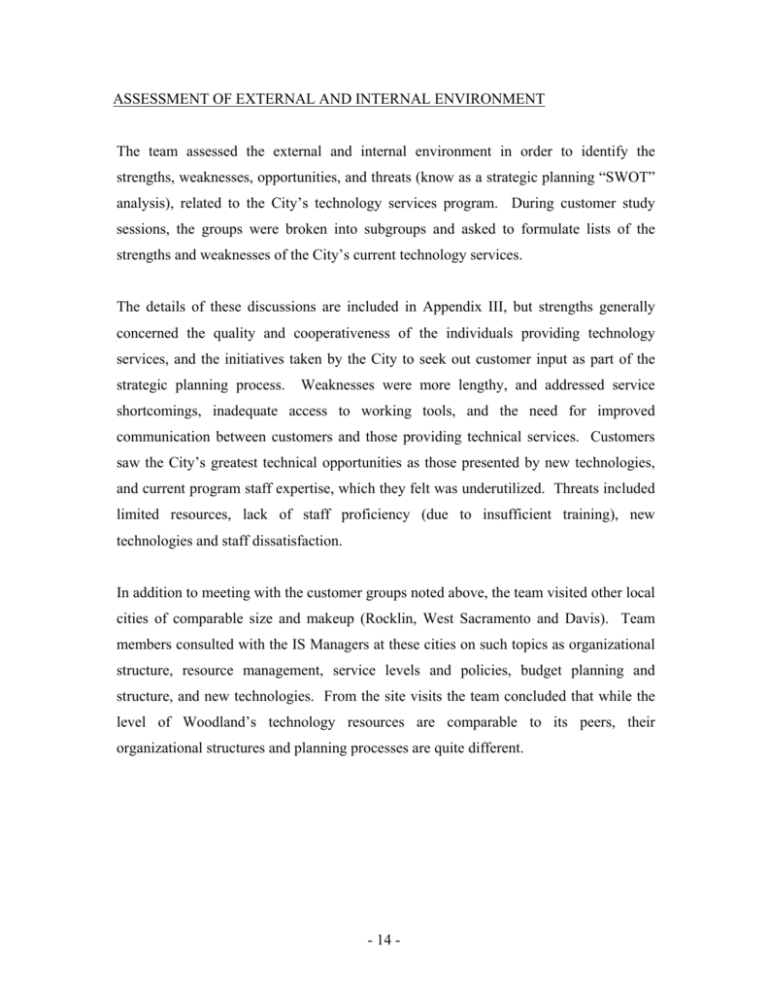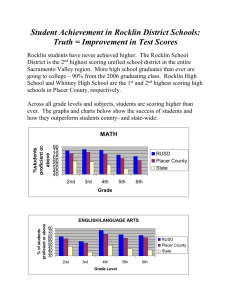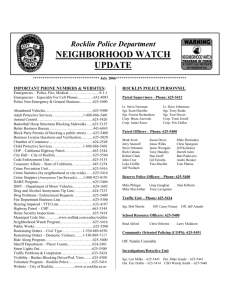ASSESSMENT OF EXTERNAL AND INTERNAL ENVIRONMENT
advertisement

ASSESSMENT OF EXTERNAL AND INTERNAL ENVIRONMENT The team assessed the external and internal environment in order to identify the strengths, weaknesses, opportunities, and threats (know as a strategic planning “SWOT” analysis), related to the City’s technology services program. During customer study sessions, the groups were broken into subgroups and asked to formulate lists of the strengths and weaknesses of the City’s current technology services. The details of these discussions are included in Appendix III, but strengths generally concerned the quality and cooperativeness of the individuals providing technology services, and the initiatives taken by the City to seek out customer input as part of the strategic planning process. Weaknesses were more lengthy, and addressed service shortcomings, inadequate access to working tools, and the need for improved communication between customers and those providing technical services. Customers saw the City’s greatest technical opportunities as those presented by new technologies, and current program staff expertise, which they felt was underutilized. Threats included limited resources, lack of staff proficiency (due to insufficient training), new technologies and staff dissatisfaction. In addition to meeting with the customer groups noted above, the team visited other local cities of comparable size and makeup (Rocklin, West Sacramento and Davis). Team members consulted with the IS Managers at these cities on such topics as organizational structure, resource management, service levels and policies, budget planning and structure, and new technologies. From the site visits the team concluded that while the level of Woodland’s technology resources are comparable to its peers, their organizational structures and planning processes are quite different. - 14 - City Profile IS Organization IS Staffing IS Division Funding* Rocklin 45,000 pop. 260 FT staff Under Administrative Services Department 6 FT: Director, Network Systems Manager, Software Analyst, 3 Technicians 1.5 PT: Intern, ½ Administrative Clerk General fund $1.9 million West Sacramento 32,250 pop. 320 FT staff Under Assistant City Manager Davis 62,200 pop. 450 FT staff Under City Manager Woodland 53,382 pop. 360 FT staff Under Finance & Police Departments 6 FT: IT Manager, 3 Specialists, 2 Application Specialists 4 PT: 4 Interns 10 FT: IS Manager, Deputy IS Manager, 3 Senior Analysts, Specialist, 2 Analysts, 2 Technicians 7 FT: IS Manager, IS Administrator, 2 IS Specialists, 3 IS Technicians 1 or 2 PT: 1 or 2 Intern(s) Impact & redevelopment fees, general fund $1.7 million Internal service fund Internal service fund $2 million $1.1 million @200 PC’s, printers 300 PC’s, printers, 400 PC’s, printers, 300 PC’s, printers, (service outsourced), phones copiers, phones phones (outsourced) copiers, phones (outsourced) In-house In-house In-house programming, PD programming, programming, CAD (dispatch) website mgt. website mgt. -Enterprise mgt. -Document mgt. -VPN concentrator -GIS Partial List of system -GIS -PD RMS & system Specific -automated Help -Document mgt. -VPN concentrator Mobile Technologies system -GIS Desk system -automated Help -WiFi in Council -VPN concentrator chambers -Laptops for EOC Desk system staff -WiFi in Council -streaming Council chambers meetings -GIS (outsourced) (outsourced) -PD RMS & Mobile -automated Help Desk system -PD RMS & Mobile -automated Council packets -PD RMS & Mobile *Rocklin’s technology funding is centralized, and reflects all IS expenditures, whereas the figures for the other three cities do not include IS expenditures contained within individual department budgets. IS Responsibilities Figure 7. Information on Comparable Cities Rocklin The City of Rocklin has made formal project management and planning a priority at the highest levels. The City has established an IS Steering Committee composed of the Department Directors and chaired by the IS Director. The Committee meets at least quarterly to address and approve IS initiatives over $5,000, or those meeting a defined threshold of time and effort. All product selection and purchasing is done by IS staff and technology funding is centralized. Department staff is encouraged to communicate - 15 - needs and challenges to IS, but not to present final solutions or products. The City has also instituted hardware and software standards, and IS staff does not install any tool that does not meet City standards. The IS program is funded completely by the general fund, and departments are required to submit technology needs and plans prior to the beginning of the budget planning process. All funding for technology initiatives is centralized under IS. The IS Director sits in on all annual department budget meetings that include IS initiatives. While the IS staff are centralized in one division and all staff are cross-trained to serve all departments, certain technicians are the acknowledged “experts” in certain program areas (such as public safety systems). West Sacramento The City of West Sacramento has taken a similarly strict approach, using an IS Steering Committee to guide all major computer purchases, and coordinating all purchasing through IS staff. IS staff also assists departments with project plans and arrange for any training associated with new initiatives. As with Rocklin, departments are encouraged to present needs to IS, rather than specific solutions. IS staff meet with department staff quarterly to ensure that everyone is adequately informed about program needs and IS plans prior to budget time. West Sacramento has also established hardware and software standards, and IS staff do not purchase or install any items that do not comply. Unlike Rocklin, they have not centralized their IS budget. Funding comes from a combination of fee and general fund revenue. Initial technology purchases are made with department funds, and ongoing costs are paid by IS. IS also pays for network and infrastructure related expenses (such as T1 lines or system upgrades). While all IS staffing resources are centralized under one division, the IS Specialists are assigned to provide support to specific departments (although all staff are cross-trained and periodically rotated). West Sacramento relies heavily on part-time, paid college interns, who have responsibility for operating all help desk services. By creating a - 16 - professional development and mentoring plan for IS staff the City has been able to recruit quality interns who are often later hired as permanent staff. The IS Directors at both Rocklin and West Sacramento addressed the challenges inherent to employing such formal management and procurement systems, noting that they constantly have to work with departments to ensure that everything is coordinated through IS. They attributed their success to City Manager support, continual and open communication, active participation in departmental budget processes, long-term planning, and quality and timely IS services. Davis The City of Davis employs a more informal approach in order to maintain maximum flexibility. While the IS staff does develop an informal list of IS goals, major computer projects are predominantly coordinated and funded by individual departments. IS provides guidance, support and project management services, but final decision-making authority resides with the departments. The City currently funds IS through an internal service fund, but plans to return to a general funding. City management feel that this arrangement will allow for more flexibility and enable IS staff to play a more proactive role. Departments secure their own funding for IS projects, but generally consult with IS beforehand. Since such consultation is not required by policy, the Director did acknowledge that department staff sometimes purchases technology and systems without IS input. IS services are centralized within one division, but the Police Department funds one of the IS Technicians, and that position is stationed at the Police Department and rotates among IS staff. The other IS Technicians are assigned to particular program areas, and also rotate responsibilities. Davis reported that one of their biggest challenges is convincing City staff to view the IS Division as a technical resource and manager of capital projects, rather than simply a provider of PC support. - 17 - Each of the cities visited utilized the following: • an automated help desk management system • an equipment replacement program • remote email access for all staff • vendor maintenance support contracts • in-house programming • mobile/wireless technology connectivity • GIS technology Areas of responsibility varied. All were responsible for PC’s, laptops, printers (although Rocklin contracts this service out), and telephones, but only Rocklin and Davis were responsible for copiers. The organizational structure at each of the three cities varied, but all reported that their IS Divisions were initially structured under their City’s Finance Department and have since been reorganized, either directly under City Management or under a separate Administrative Services Department. All of the cities identified training as one of their primary challenges. While each city had tried a variety of approaches – in-house training, online training, off-site contractor provided training – none reported a method that had completely met department and IS staff needs. - 18 -








